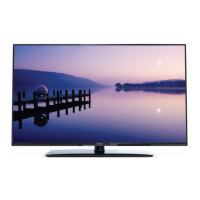
Do you have a question about the Philips 47PFL6188K/12 and is the answer not in the manual?
Details on product information, getting started, manuals, FAQs, and software.
Explains how to connect various external devices to the television.
Detailed description of all available connections and their functions.
Essential safety regulations and procedures to follow during repair.
Lists critical warnings related to product operation and maintenance.
Step-by-step instructions for removing the main assembly or panel.
Guidance on re-assembling the television set after servicing.
Explains different service modes like SDM, SAM, and CSM for diagnostics and settings.
Details the purpose and activation of the Service Default Mode for pre-defined settings.
Information on the Service Alignment Mode for electrical adjustments.
Details the purpose and activation of Customer Service Mode for remote diagnostics.
Describes the start-up sequence diagrams and conditions.
Explains the error code buffer, logging, and how errors are displayed.
Introduction to error code buffer mechanics and error logging.
Provides methods to clear the error buffer, including SAM menu and blinking LED.
Details on error detection mechanisms and the importance of clearing the buffer.
Explains the procedure for interpreting LED blinking errors for diagnosis.
Introduction to the blinking LED procedure for error indication.
Describes how to activate the blinking LED procedure using CSM or SDM.
Details the software protections implemented in the set.
Explains the types of software-related protections and fault conditions.
General tips for locating failures and checking fuses.
Describes the Customer Service Mode functionality and USB data dumping.
Details the power supply architecture and voltage distribution within the chassis.
Guidance on debugging DC/DC converters by checking their start-up sequence.
Explanation of Uart logging cases and analysis.
Explains how to run the memory test and interpret its results.
Recommendations for checking LED drivers on PSL(S) when no picture or backlight is present.
Importance of checking and setting the correct display option code after SSB replacement.
Detailed instructions and flowchart for replacing the SSB.
Explains automatic and manual software upgrade procedures.
Details the process for automatic software upgrades via USB.
Alternative method to manually activate the backup software upgrade application.
Instructions for upgrading the Standby software using a USB stick.
Specifies the conditions and prerequisites for performing electrical alignments.
Step-by-step sequence for setting correct options and performing alignments.
Procedure for adjusting white point settings and colour temperature for LCD screens.
Tables providing default white tone settings for various PFL and PDL series.
Explains how the microprocessor communicates with I2C ICs using option numbers.
Introduction to option settings and their importance for communication and diagnosis.
Instructions for resetting the NVM on a repaired SSB and setting type/production codes.
How to identify the correct ordering number (12nc) for a replacement SSB.
A comprehensive overview of SAM modes available for service technicians.
Introduction to the QFU1.2E LA chassis and its relation to the FUSION platform.
Overview of the FUSION 2013 architecture, referring to block diagrams.
Describes the power supply unit as a black box and replacement procedures.
Information on ordering new boards and replacing defective ones, fuse replacement.
Refers to figure 7-2 for the general power architecture.
Block diagram and pin configurations of the DVBT2 channel decoder IC.
Overall block diagram of the TV system architecture, showing major components and interfaces.
Detailed block diagram illustrating the power supply lines and voltage regulators.












